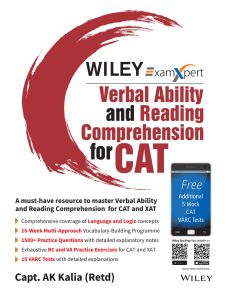Wiley's ExamXpert Verbal Ability and Reading Comprehension for CAT
ISBN: 9788126558063
1016 pages
For more information write to us at: acadmktg@wiley.com

Description
This book is a one-stop solution (over 1000 pages) for CAT, XAT and other MBA Entrance exams. The core of the book is the comprehensive coverage of Language and Logic concepts in order to build your overall proficiency in language skills. The book provides 12 exhaustive RC and VA Practice Exercises for assimilating concepts and 20 VARC Tests for testing your level of preparedness and fine-tuning your exam strategy. The book also provides a 16-Week Vocabulary Building Programme based on a multi-pronged approach for learning words in related groups for the multiplier effect and ease of retention.
Preface
Section 1 Introduction
Chapter 1: An Integrated Approach to Proficiency in English Language
Introduction
An Integrated Approach
Proficiency in English Language: The 4-F Framework
Chapter 2: The Changing CAT Pattern
Changes in CAT Pattern
Diagnostic Tests—A Foretaste of CAT VARC Section
Chapter 3: Using This Book
Structure of the Book
Chapter 4: Gearing up for CAT
The CAT Exam: The Entry Point to your Dream B-School
The CAT 2017 Exam Structure and Experience
Section 2 Diagnostic Tests
CAT VARC Diagnostic Test 1 (Based on Latest Pattern)
Questions
Answer Key
Explanatory Answers
CAT VARC Diagnostic Test 2 (Based on Old Pattern)
Questions
Answer Key
Explanatory Answers
Section 3 Concept Review
Chapter 5: Reading Comprehension: Vocabulary, Level of Language and Subject-Matter
Hurdles to Reading Comprehension
Level of Language and Range of Vocabulary
Some Reading Tasks to Challenge you
Answer Key
Explanatory Answers
Chapter 6: Reading in Thought Units: Unravelling Grammar Syntax
Forming Regular Reading Habits
Understanding Grammar Syntax
Review of Grammar Syntax
Internalizing Complex Grammar Syntax
Explanatory Answers Along with the Questions
Chapter 7: Reading Comprehension: Clear and Logical Composition of Texts
Integrated Approach: The Expanded 5-F Framework
Ambiguity and Logical Inconsistency
Handling Negatives
Understanding Logical Equivalence
Analysis and Evaluation of Arguments
Types of Reasoning: Deductive and Inductive
Deductive Reasoning
Inductive Reasoning
Types of Critical Reasoning Questions
Separating Facts, Inferences, and Judgements
Answer Key
Explanatory Answers
Chapter 8: Reading Comprehension: Sentences to Paragraphs
Coherence and Fluency of Thought-Flow
Grammatical Linking and Signposting
Jumbled Paragraphs: Test Your Ability to ‘Read with The Eye of a Writer’
What Makes a Good Starting Sentence
‘Tell and Show’ or ‘Show and Tell’
‘Tell and Show’
‘Show and Tell’
Chronological or Logical
Developing Thought-flow by ‘Linking Back’ to Earlier Thoughts
Repetition and Parallel Grammatical Structures
What Makes A Good Concluding Sentence
Summary of Guidelines for Unravelling Jumbled Paragraphs
Types of Jumbled Paragraph Questions (MCQ And TITA)
Answer Key
Explanatory Answers
Chapter 9: Reading Comprehension: Summarizing and Active Reading
(Paragraph Summary Writing)
Summarizing: A Basic Reading Comprehension Skill
The Technique of Active Reading
Answer Key
Explanatory Answers
Chapter 10: Reading Comprehension: Levels of Meaning and RC Question-Types
Levels of Meaning and Related RC Question-Types
Wording of Question-Stems and Option traps
Answer Key
Explanatory Answers
Chapter 11: Reading Comprehension: Reading for Structure (Evaluative Level of Meaning)
The Main Idea Question: The Most Important and Frequently-Asked RC Question
Some RC Question-Types That Entail ‘Evaluation’
Answer Key
Explanatory Answers
Chapter 12: Reading Comprehension: Reading for Implied Idea (Inferential Level of Meaning)
A Quick Recap of the ‘Concept Review’ Section
Inferential Level of Meaning: RC Question-types
Answer Key
Explanatory Answers
Section 4 Practice Exercises
Practice Exercise 1: Reading Comprehension (Paragraph Summary Writing)
Questions
Answer Key
Explanatory Answers
Practice Exercise 2: Reading Comprehension (Short Passages-1)
Questions
Answer Key
Explanatory Answers
Practice Exercise 3: Reading C

